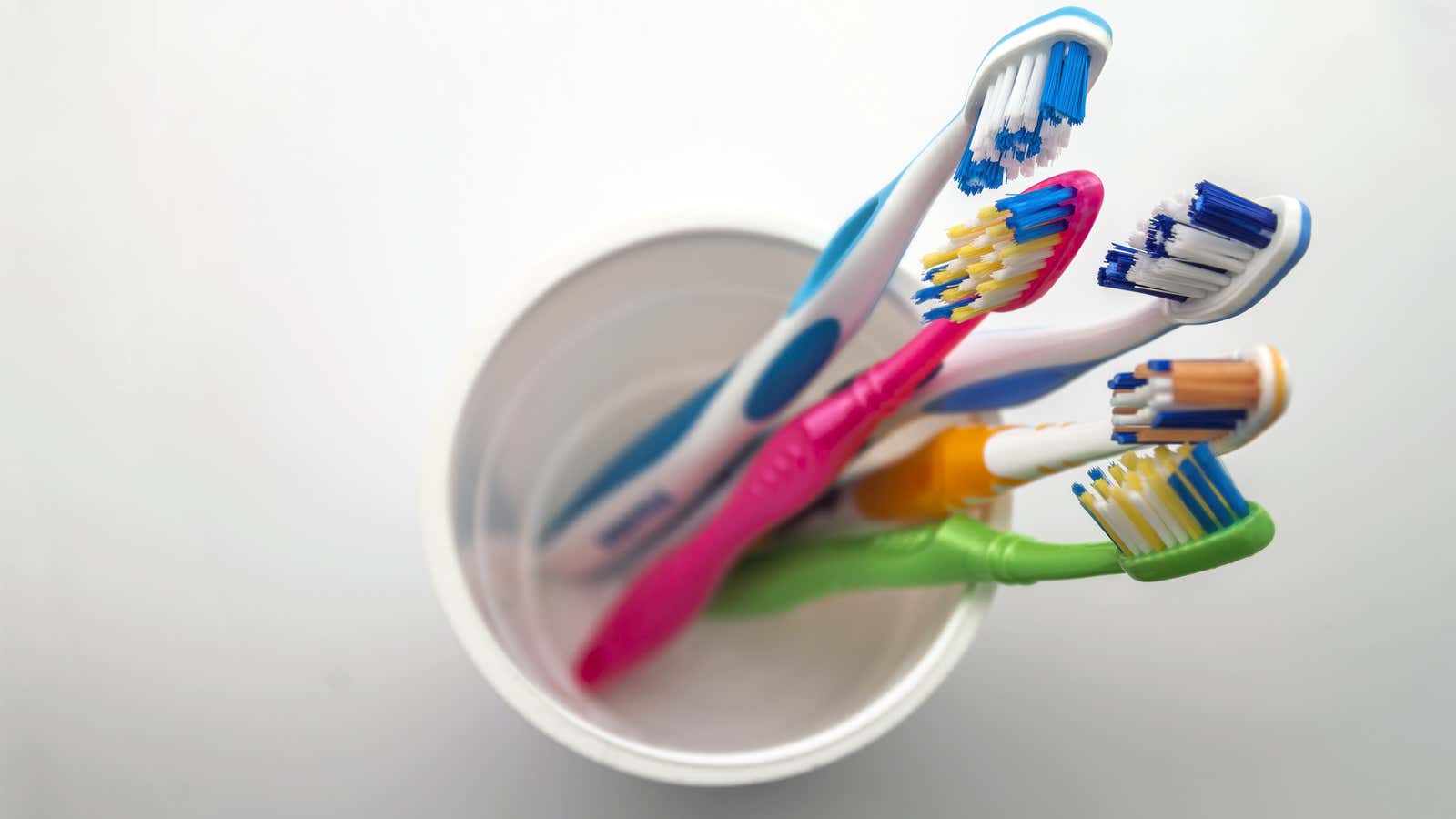There Is No Such Thing As a “clean” Toothbrush.

There are two types of people in the world. The type who mindlessly stores his toothbrushes out in the open, in the same bathroom as the toilet spewing feces (disgusting, right?), and the type who does his best to cover his toothbrushes when not in use, and even sanitize them periodically in the dishwasher or with a fancy UV sterilizer. Guess which of these two groups follows the CDC and ADA guidelines for toothbrush care? Surprise, these are lazy people.
But aren’t their toothbrushes covered in bacteria and other nasty little germs? They definitely are. All toothbrushes are full of germs, and most of them come from our mouths. This review of studies on toothbrush contamination reports that they all “found significant retention and survival of bacteria on toothbrushes after use.”
Toothbrushes start with germs (they come clean from the factory, but not sterile, after all) and quickly pick up all the germs you have in your mouth. If you have pathogenic germs in your mouth (gum disease, herpes), they will get on the toothbrush and you will not be able to completely remove them. And here’s a fun bonus: as toothbrushes age, their surface wears down and they can harbor even more germs.
You won’t die from toothbrush germs
Before we go any further, let’s get one thing clear: while the thought of germs on a toothbrush may turn you off, it’s actually not a health hazard for most people. The CDC advises that people with bleeding disorders or who are immunosuppressed may need to find other ways to take care of their oral health, and if that’s you, talk to your doctor. For the rest of us: “The Centers for Disease Control and Prevention is not aware of any adverse health effects directly related to toothbrushing.”
Let your toothbrush dry
The best way to deal with all these germs? According to the CDC and the American Dental Association , air drying is key.
Rinse your toothbrush with tap water after brushing. This does not remove bacteria, but it does get rid of any toothpaste clumps or other debris that might interfere with the drying process. Place your toothbrush in a holder that will allow it to sit upright and air dry. Drying out bacteria is what keeps them from multiplying. Storing used toothbrushes in a container or putting a lid on them can encourage bacterial growth. The few germs you keep out will outnumber the germs that roam inside.
Learn more about proper toothbrush care:
- Don’t share toothbrushes; keep the rest of the bodily fluid with you.
- For the same reason, don’t let your toothbrush come into contact with someone else’s toothbrush.
- Replace your toothbrush when it wears out, or approximately every three to four months. Toothbrushes clean your teeth best (and contain fewer bacteria) when they are in good condition.
If the thought of bacteria irritates you so much that you feel like you have to do something about it, the ADA advises you to soak your toothbrush in Listerine or 3% hydrogen peroxide (the stuff you buy in a brown bottle at the drugstore). It won’t kill all bacteria, but it can reduce their levels by 85%. (Now 85% of the bajillions are still bajillions, but it might make you feel better.)
Do not put your toothbrush in the dishwasher or microwave; this can kill bacteria but will also damage the toothbrush. Experts seem divided over ultraviolet (UV) sterilizers. The CDC says they “may damage” toothbrushes; The ADA acknowledges that they exist, but makes no recommendations for or against them.
So is there poop on my toothbrush or not?
So what about those toilet plumes? It’s true that toilets can throw droplets into the air , some of which evaporate as aerosols that can float around the room and possibly end up on your toothbrush or other items.
But there are no studies that directly link toilet-derived aerosols to toothbrushes causing disease in humans. Instead, we have studies like this dissertation that found traces of potentially fecal bacteria on 60% of toothbrushes stored in public bathrooms (an average of nine people use a bathroom). But there was no control group in this study; this was not a comparison of toothbrushes stored in bathrooms with toothbrushes stored elsewhere, it was just a review of toothbrushes. (The bacteria were also found to be more common on toothbrushes that were rinsed with mouthwash, suggesting that soaking mouthwash may not be the best way to alleviate your germ phobia.)
On the other hand, the Microbiome Project has sequenced the microbes found on the toothbrushes of volunteers across the country and has been unable to find conclusive evidence that toothbrushes are colonized by fecal bacteria. (Earlier research, including the dissertation, used methods that couldn’t tell for sure whether microbes originated from feces, they just seemed to belong to the same families as regular fecal microbes.) our poop on your toothbrush.” , said one of the Gizmodo contributors .
Whether there are germs on your toothbrush or not, we have already established that it is better to let the germs dry than to incubate them in a closed container. You can store your toothbrush in another room if you like, but keep an eye out for any hidden germs in that room.